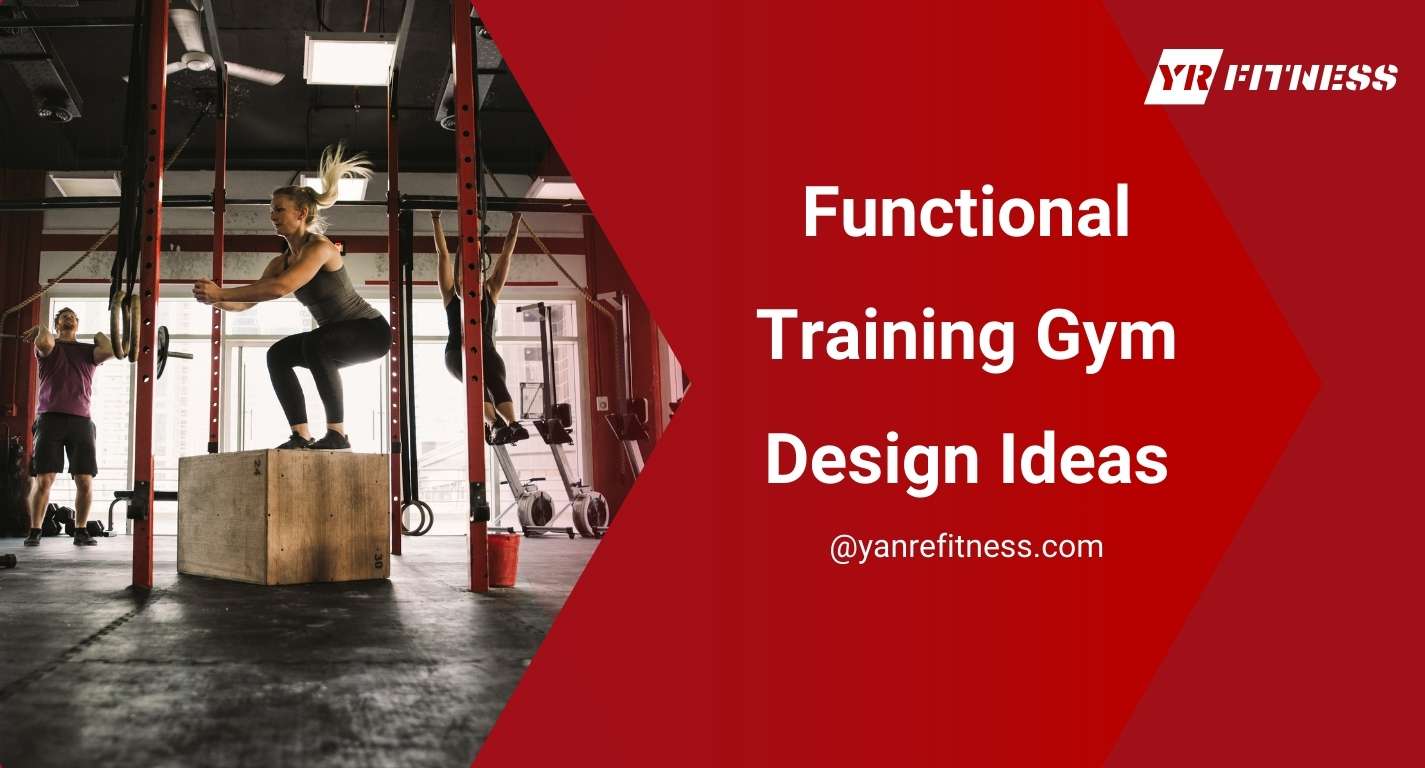Have you ever wondered what makes a functional training gym successful and highly efficient? The answer lies in the details of design and thoughtful planning that maximize both performance and profitability.
As an experienced gym owner, I understand that creating the perfect environment goes beyond picking out equipment. It’s about combining strategy with practicality to meet the diverse needs of your members.
Here’s a quick look at 2 elements that are essential for functional gym design:
- Lighting
- Acoustics and Sound Control
In this guide, we’ll dive deep into the essential elements of gym design, covering everything from equipment placement to acoustics and lighting.
So let’s dive in!
Table of Contents
1. Market Research and Target Audience
Before designing a functional training gym, it’s essential to thoroughly understand the market and the specific needs of your target audience. A well-defined target audience can make the difference between a thriving gym and one that struggles to attract members. Here are 3 key considerations when conducting market research:
Demographics and Fitness Trends
Are you targeting beginners, advanced athletes, or a mix? Understanding whether your audience prefers group classes, one-on-one training, or individual workouts will help inform equipment selection and class offerings. Additionally, keeping up with emerging fitness trends such as HIIT, functional movement, or active recovery training can ensure your gym stays relevant.
Competitor Analysis
Researching other gyms in your area gives insight into what works and what doesn’t. This can help you identify gaps in the market, such as the lack of a dedicated functional training space or specialized equipment that sets you apart. Knowing what competitors are offering also allows you to differentiate yourself with unique design elements or niche services.
Member Experience and Preferences
Understanding what members value most in a gym is crucial. Some may prioritize cutting-edge equipment, while others might be drawn to a sense of community or a clean, welcoming environment. Surveying potential clients or existing members about their preferences for layout, class types, and amenities can help you create a space that meets their needs while fostering long-term loyalty.
2. Layout and Flow
A gym’s layout should not only support efficient movement but also create an environment that enhances the overall training experience. Here are 5 key elements to consider when organizing the layout and flow of your gym:
- Defined Training Zones: Clearly separate areas for different types of training, such as functional fitness, cardio, and strength training. This helps create a natural flow and reduces distractions, allowing members to move from one section to another with purpose.
- Open Concept Design: Allow for open spaces where members can perform dynamic movements such as lunges, plyometrics, or bodyweight exercises. An open layout encourages functional training and group workouts without members feeling confined or restricted by equipment.
- Intuitive Traffic Flow: Design the layout to naturally guide members through the gym, with a clear path from the entrance to the various workout zones. On top of that, create logical transitions between sections to avoid bottlenecks.
- Visibility and Line of Sight: Position the gym’s layout in a way that allows staff to easily monitor all areas of the facility. Keeping the front desk in view of the main workout floor helps create a sense of connection between staff and members, making it easier to address any needs or concerns quickly.
- Flow for Group and Individual Training: If group classes are part of your gym’s offering, plan spaces that accommodate both group and individual workouts without overlap. Consider scheduling group classes in dedicated rooms or spaces away from the general gym floor.

3. Equipment Selection and Placement
The right selection and strategic placement of equipment can make or break the functionality and appeal of a gym. Below are key factors to keep in mind when selecting and placing your gym equipment:
Catering to Diverse Training Needs
Choose equipment that accommodates a range of training styles, from functional training gear like kettlebells and battle ropes to more traditional machines such as treadmills and weight stacks. This variety will appeal to a wider audience, offering options for strength, cardio, and mobility-focused workouts.
Space Efficiency
Place equipment in a way that maximizes floor space while maintaining accessibility. Group similar machines together to create efficient workout zones, such as placing free weights near benches or pairing cardio machines together. Similarly, functional training tools should be kept in open areas where members can move freely and perform dynamic exercises.
Aesthetic Alignment
Select equipment that matches the overall branding and design aesthetic of the gym. Colors, shapes, and materials should complement the space to create a cohesive look. For example, sleek, modern equipment might enhance a high-end gym’s appeal, while more industrial styles may align with a gritty, performance-focused environment.
Quality and Durability
Investing in high-quality, durable equipment is critical for long-term profitability. Brands like YR Fitness, known for their reliable and high-performing machines, can provide the kind of equipment that stands up to heavy use over time. Prioritizing quality also reduces the likelihood of maintenance issues that can disrupt the gym’s flow.
When designing a functional training gym, it’s crucial to select equipment that caters to various training styles. Below is a summary of recommended equipment types and their ideal placement to optimize space and enhance member experience.
Training Style | Recommended Equipment | Ideal Placement |
Strength Training | Power racks, barbells, dumbbells, weight benches | Near the free weights section, spaced evenly |
Cardio Training | Treadmills, ellipticals, rowers, stationary bikes | In rows or staggered arrangement for easy access |
Functional Training | Kettlebells, battle ropes, medicine balls, resistance bands | Open space for free movement and circuits |
Flexibility/Mobility | Yoga mats, foam rollers, stretch bands | Dedicated stretching zones away from heavy equipment |
Group Training | Sandbags, sleds, plyo boxes, TRX systems | Separate group training area or multi-use spaces |
4. Safety and Accessibility
A well-designed space minimizes the risk of injury and makes fitness equipment and facilities easy to use for people of all abilities. Here are 3 critical aspects to consider when designing for safety and accessibility:
Clear Walkways and Adequate Spacing
Equipment should be arranged to allow for easy movement between workout zones without creating bottlenecks or hazards. Maintain wide walkways and leave enough space between machines so members can move safely without the risk of tripping or bumping into others. The fact is, a gym that feels open and easy to navigate can prevent many common gym injuries.
Accessible Equipment and Features
It’s important to include equipment and design features that accommodate people with disabilities or limited mobility. For instance, this might involve adding low-impact machines, adjustable equipment, or ramps where necessary. Providing accessible changing rooms and bathrooms with non-slip flooring and grab bars also promotes inclusivity for all gym-goers.
Clear Safety Signage and Emergency Plans
Proper signage is crucial for member safety. Display clear instructions for using equipment and make sure emergency exits are well-marked. For instance, having a visible emergency plan and accessible first aid stations throughout the gym enhances the overall safety of the facility. Staff should be trained to handle any emergency situations, from minor injuries to more serious incidents.

5. Lighting
Good lighting can enhance member experience by improving visibility, creating the right mood, and highlighting key areas. Here are essential aspects to consider when designing the lighting for your gym:
- Natural Lighting: Large windows or skylights can brighten up the space, boosting both mood and performance. Exposure to daylight also contributes to a more inviting atmosphere, helping members feel comfortable and motivated.
- Task Lighting: In areas where precision is important, such as weightlifting zones, use focused task lighting. This type of lighting helps members clearly see equipment and their form, which can reduce the likelihood of accidents.
- Ambient Lighting for Mood: Ambient lighting is key for setting the tone in different sections of the gym. In like manner, color-changing LED lights can be used to create dynamic effects for group classes or events.
- Dimmable Lighting Options: Brighter settings may be used during peak hours, while dimmer lighting can be implemented for evening classes or recovery sessions. This adaptability helps cater to different workout styles and times of day.
- Energy Efficiency: Choosing energy-efficient lighting options, such as LED bulbs, can help reduce operational costs in the long term. These lights not only consume less energy but also have a longer lifespan, which cuts down on maintenance needs.
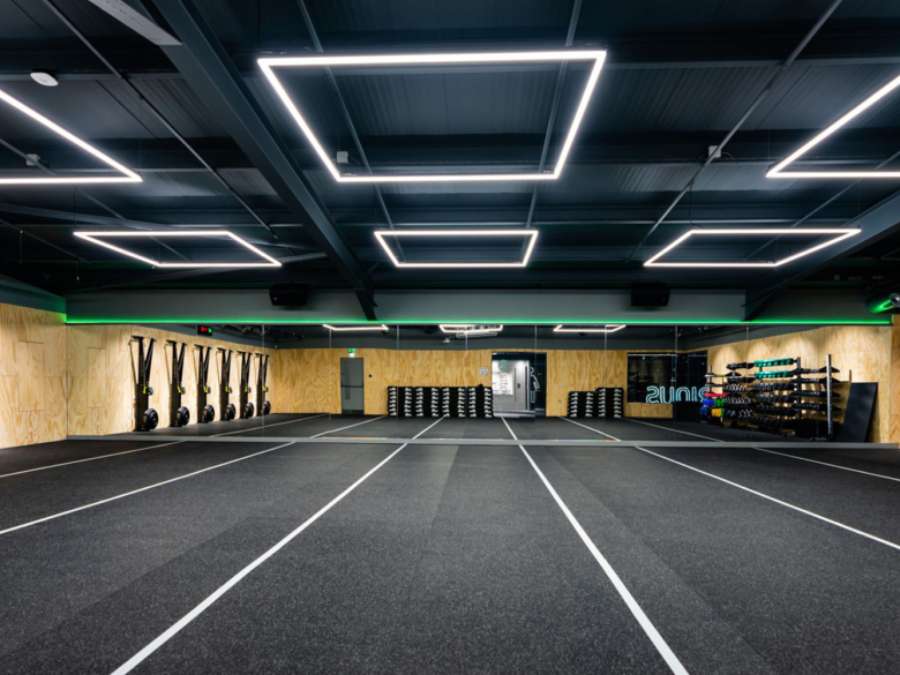
6. Acoustics and Sound Control
Managing noise levels prevents distractions, enhances the atmosphere, and improves the overall experience for your members. Below are 4 key considerations for managing acoustics and sound control in your gym:
- Soundproofing and Noise Reduction: Acoustic panels, rubber flooring, and other sound-absorbing materials can help reduce the echo and noise from weights dropping or high-energy group classes.
- Separate Noisy and Quiet Zones: Noisy areas can be placed further away from quieter spaces. According to Huffpost, loudness of over 100dB is stressful and uncomfortable for yoga classes.Insimilar fashion, placing group exercise rooms with proper insulation will keep the sound from affecting the rest of the gym.
- Music and Speaker Placement: Music can boost energy levels and set the tone, but it needs to be well-managed. Strategically place speakers so that sound is distributed evenly throughout the gym without being overwhelming in any one area.
- Noise-Cancelling Features for Relaxation Areas: In areas meant for relaxation or recovery, consider incorporating noise-cancelling features. This could include soft furnishings or curtains that absorb sound, creating a calmer atmosphere.
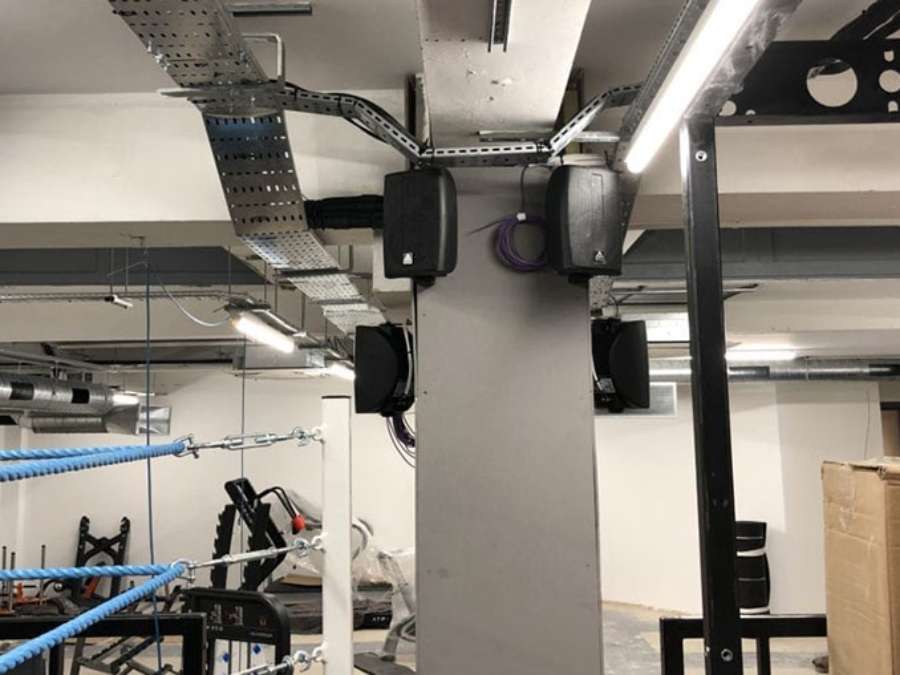
7. Branding and Aesthetics
Branding and aesthetics are key to creating a gym that resonates with members and reflects the identity of the business. Here are important aspects to focus on when designing your gym’s branding and aesthetics:
Consistency in Design
Your gym’s visual identity should be consistent across all touchpoints, from signage and walls to equipment and marketing materials. The color palette, font, and overall theme should create a cohesive look that reflects your brand. The point is that consistent aesthetics help build brand recognition and create a professional, polished feel that appeals to members.
Functional yet Appealing Design
While aesthetics are important, they should not compromise the functionality of the space. Choose design elements that complement the gym’s purpose, such as durable materials that can withstand heavy use but still look visually appealing. Incorporating your branding into functional items like lockers, benches, or flooring can reinforce your brand without sacrificing practicality.
Creating an Emotional Connection
A well-designed gym can evoke positive emotions and contribute to member loyalty. The use of motivational wall art, brand-specific messaging, or carefully chosen lighting can inspire members during their workouts. Additionally, creating spaces that reflect the gym’s mission—whether it’s performance-driven or community-focused—can help members feel more connected to the brand.
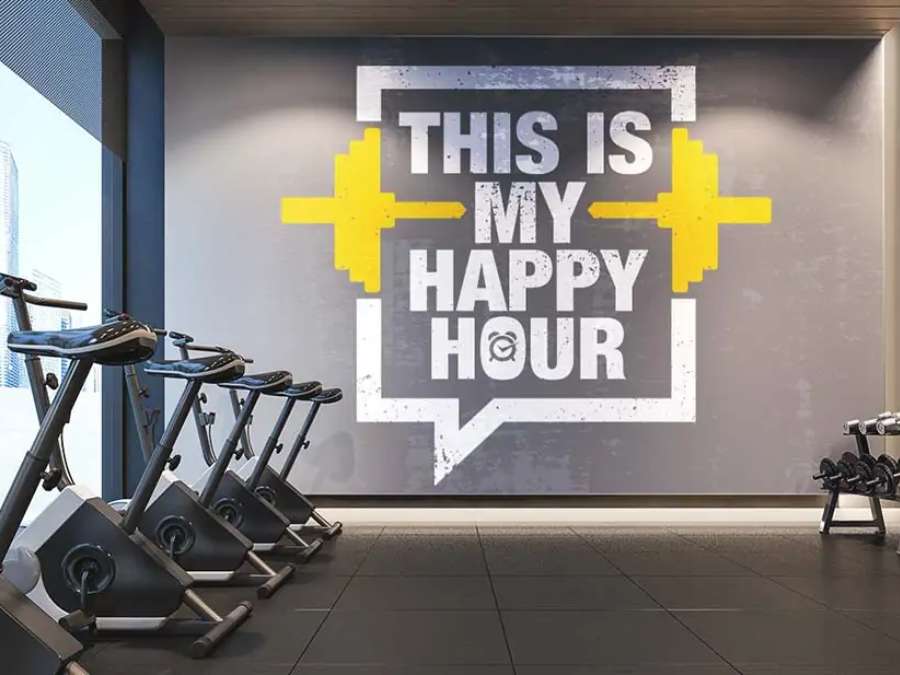
8. Architectural Elements
From structural decisions to material choices, every aspect contributes to how the space is used and how it feels to members. Here are 4 key architectural elements to consider when designing your gym:
Ceiling Height and Open Spaces
High ceilings and open spaces are ideal for functional training areas where members need room for dynamic movements like kettlebell swings or plyometric exercises. In strength training areas, consider overhead clearance for taller machines and rigs from brands like YR Fitness, which often require extra space for full functionality.
Natural Light and Ventilation
Incorporating natural light and ventilation enhances the atmosphere of your gym by creating a fresh and inviting space. Large windows or skylights can bring in daylight, reducing the need for artificial lighting during the day. This involves strategically placing windows to avoid glare on mirrors or screens and integrating ventilation systems to maintain air quality and temperature, even during peak hours.
Durable, Aesthetic Materials
The choice of materials plays a key role in both the look and longevity of the gym. Flooring materials need to withstand heavy weights and high foot traffic while remaining visually appealing. Walls, doors, and other surfaces should be built to handle wear and tear without looking worn down over time, contributing to the overall polished look of the facility.
Integrated Structural Design
The architectural design should integrate with the gym’s overall layout, keeping functionality in mind. This involves creating spaces that flow well together, such as placing locker rooms near entryways and ensuring easy access to workout zones. Additionally, structural elements like beams and columns should be incorporated in a way that doesn’t interfere with workout areas, maintaining both safety and accessibility.
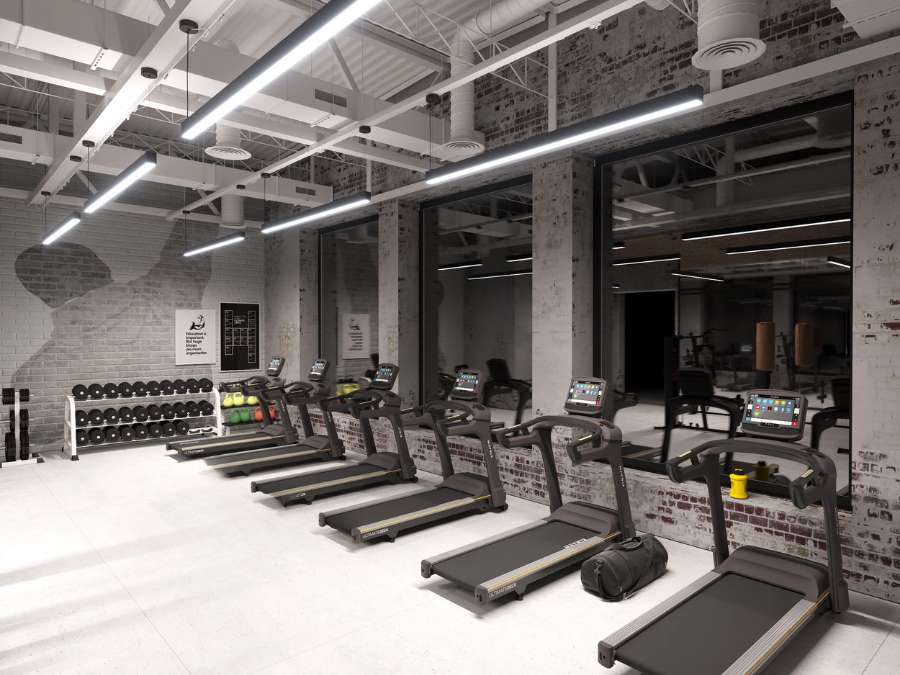
Conclusion
Designing a functional training gym that maximizes performance and profitability requires thoughtful consideration of key elements like layout, equipment placement, lighting, and acoustics. Each decision, from the architectural design to the branding and aesthetics, plays a vital role in creating an environment that enhances member experience and drives long-term success.
We hope this guide has provided valuable insights to help you make informed choices. At YR Fitness, we specialize in manufacturing high-quality, durable commercial gym equipment that meets the demands of high-performance fitness environments. If you’re looking for reliable and innovative equipment to elevate your gym’s design, contact us today to see how we can support your vision.
Dive Deeper Into Our Resources
For some insightful reads, we’ve curated a list of recommended articles just for you:
Still haven’t found what you’re looking for? Don’t hesitate to contact us. We’re available around the clock to assist you.
Related articles:
